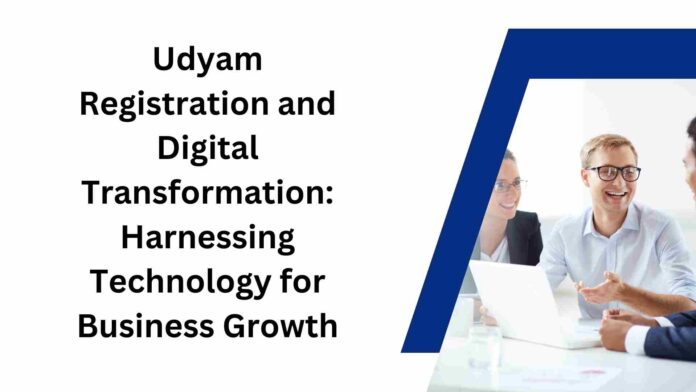“Udyam Registration” refers to the online registration process introduced by the Government of India for micro, small, and medium-sized enterprises (MSMEs). This registration is mandatory for businesses seeking to avail themselves of the various benefits and schemes provided by the government to promote and support the MSME sector.
The term “Udyam” is a Hindi word that translates to “enterprise” or “business.” The Udyam Registration Online process replaced the earlier system of MSME registration known as Udyog Aadhaar in 2020.
Embracing Digital Tools in Udyam Registration:
The Udyam Registration process has evolved significantly with the integration of digital platforms. Entrepreneurs can now complete the registration seamlessly online, reducing the bureaucratic hassles traditionally associated with paperwork. Digital tools have streamlined the documentation process, allowing businesses to submit and verify necessary documents efficiently.
Moreover, online platforms offer real-time tracking, enabling entrepreneurs to monitor the status of their Udyam Registration application. This transparency not only saves time but also ensures a smoother experience for businesses, fostering a positive environment for growth.
Enhanced Connectivity and Accessibility:
Digital transformation through Udyam Registration brings increased connectivity and accessibility. Entrepreneurs from remote areas can now participate in the formal economy without geographical constraints. Online registration facilitates a more inclusive environment, empowering businesses irrespective of their location.
Furthermore, the digitalization of Udyam Registration has paved the way for improved communication channels between entrepreneurs and government authorities. This enhanced connectivity enables faster query resolution and ensures that businesses receive timely updates, fostering a collaborative ecosystem.
Data-Driven Decision-Making:
One of the significant advantages of digital transformation in the context of Udyam Registration is the ability to collect and analyze data. Digital platforms capture valuable insights into the registration process, allowing authorities to identify trends, areas for improvement, and potential bottlenecks.
For entrepreneurs, this data-driven approach can inform strategic decision-making. By understanding common challenges faced during the Udyam Registration process, businesses can adapt and tailor their operations for better efficiency and compliance.
Digital Tools Facilitating Udyam Registration:
The integration of digital tools extends beyond the registration process itself. Entrepreneurs can now access online resources, tutorials, and guides that demystify the intricacies of Udyam Registration. Webinars and online seminars conducted by government agencies provide invaluable insights, ensuring that businesses are well-informed and equipped to navigate the registration process successfully.
Additionally, digital platforms offer self-assessment tools that help entrepreneurs determine their eligibility for Udyam Registration. These tools guide businesses in understanding the criteria and documentation requirements, simplifying the overall process and reducing the likelihood of errors.
Elevating Financial Inclusion:
Digital transformation through Udyam Registration profoundly impacts financial inclusion for small businesses. The registration process opens doors to various government schemes and financial assistance programs designed to support micro, small, and medium enterprises (MSMEs). Digital platforms serve as a bridge, connecting businesses to these financial opportunities.
Moreover, the digitalization of financial transactions enables businesses to maintain transparent and auditable records. This not only facilitates smoother interactions with financial institutions but also enhances the credibility of businesses, making them more attractive to potential investors and partners.
Cybersecurity Considerations:
While the advantages of digital transformation in Udyam Registration are evident, it is crucial to address cybersecurity concerns. As businesses transition to online platforms, protecting sensitive information becomes paramount. Entrepreneurs must prioritize cybersecurity measures, such as secure data encryption and regular system audits, to safeguard their information and maintain the integrity of the registration process.
Collaboration between government agencies and technology experts is essential to ensure the resilience of digital platforms. Establishing robust cybersecurity protocols will foster trust among businesses, encouraging widespread adoption of digital tools for Udyam Registration.
Note: You can also Update MSME Certificate
Looking Ahead: Future Prospects of Udyam Registration and Digital Transformation:
The synergy between Udyam Registration and digital transformation is an ongoing journey with vast potential. Future developments may include the integration of artificial intelligence (AI) and machine learning (ML) algorithms to further streamline the registration process. Predictive analytics could be employed to anticipate potential challenges, allowing businesses to address issues before they become obstacles proactively.
Furthermore, increased collaboration between government bodies, private enterprises, and technology firms may result in the development of comprehensive digital ecosystems that support businesses throughout their lifecycle. This holistic approach could extend beyond registration to encompass ongoing compliance, access to marketplaces, and opportunities for skill development.
Conclusion:
Udyam Registration and digital transformation go hand in hand, presenting entrepreneurs with an opportunity to not only formalize their businesses but also to thrive in the digital age. The synergy between technology and the Udyam Registration process streamlines operations, enhances accessibility, and facilitates data-driven decision-making.
As India continues to embrace a digital-first approach, entrepreneurs must recognize the transformative power of technology in driving business growth. Udyam Registration serves as a gateway, and when coupled with digital tools, it becomes a catalyst for a more robust, connected, and technologically empowered small business ecosystem. Embracing this intersection will not only simplify regulatory processes but also position businesses to capitalize on the myriad opportunities offered by the digital landscape. In the journey of Udyam Registration and beyond, technology is not just a tool; it’s a strategic asset that propels businesses toward sustained success.

